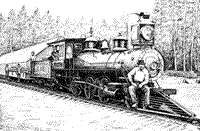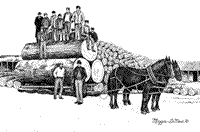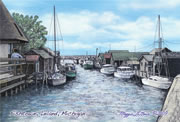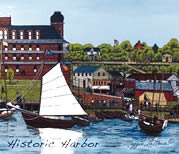Prints & Cards
More information about Giclée Prints.
See the information about the history of bicycling on the bicycle page.
See the information about the history of automobiles on the Old-Time Cars page.
Some excerpts from a wonderful article about the effect of the automobile on American life
From Motor City to Motor Metropolis: How the Automobile Industry Reshaped Urban America
by Thomas J. Sugrue
No technology has had a greater impact on American everyday life than the automobile. Where we live, how we work, how we travel, what our landscape looks like, our environment have all been profoundly shaped by the car.
The thirteenth largest city in the United States in 1900 with 285,000 residents, Detroit was compact. Most of its population lived within a few mile radius of downtown. As in the case of most nineteenth-century industrial cities, its manufacturing clustered along the river, whose water provided power and easy transportation for incoming supplies and outgoing goods.
No one industry dominated. Over the next thirty years, the auto industry took off. By the onset of the Great Depression, car manufacturing completely dwarfed manufacturing concerns in Detroit. Detroit was ideally situated to be a center of the American automobile industry. Detroit was in the center of America's industrial heartland.
All of the raw materials needed for automobile production were easily accessible to the city by the Great Lakes waterways and by rail.Detroit's first auto plants were small operations, but as Ford pioneered the techniques of mass production at the new Highland Park PlantBut by far the most ambitious and landscape-altering plant was Ford's vast River Rouge complex. Finished in 1927, the River Rouge plant consisted of nineteen separate buildings in a vast industrial complex.
industry was labor-hungry. A ready supply of workers who had been displaced by the decline of the logging industryMany new autoworkers hailed from Canada--which by 1910 had become the leading source of immigration to the Motor City. Increasingly, auto manufacturers cast their nets more widely.
Ford led the way. His firm recruited skilled workers from the industrial cities of England and Scotland. Ever eager to find new sources of labor, Ford extended his firm's recruiting networks abroad, to places as far afield as Mexico and the Middle East. World War I and the immigration restriction acts of 1921 and 1924 dramatically reduced the supply of foreign-born workers to the United States just at a moment when the auto industry grew exponentially and demand for unskilled labor soared.
Immigration from southern and eastern Europe came to a near halt. Beginning in World War I, in response to a decline in immigration and a labor shortage, Ford began to hire African American workers.
In the 1910s and 1920s, the black migrants headed by the millions to the urban north, displaced by the South's agricultural depression and by the depredations of Jim Crow. Unlike many employers who shied away from hiring blacks, Ford built relationships with African American church leaders, using them to screen for the most qualified (often, because of the lack of good jobs, overqualified) workers.
Source: http://www.autolife.umd.umich.edu/Race/R_Overview/R_Overview.htm
Books by Thomas J. Sugrue : from Amazon
Below is a flier that includes some scenes we have not yet posted on this website
|
Contact Michigan Prints. -- Ask us about our sale on the new limited edition prints - Buy One Get One 50% off. Also ask about new assortments of boxed cards - ask about your choice of the selections. See new sizes and pricing at the bottom of this page. |
Other series from Michigan Prints
|
|
||
| Albion College |
Back to Michigan Prints Home Page
MichiganPrints.com
a Division of
AlbionDesign.com
Communications Specialists
- Since 1981 -
©2021 Maggie LaNoue / Albion Design
Copyright information































